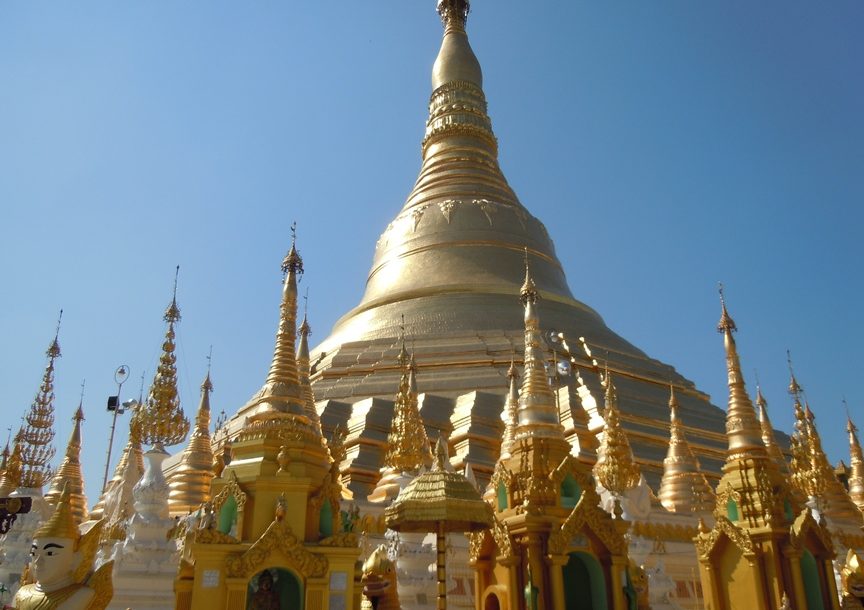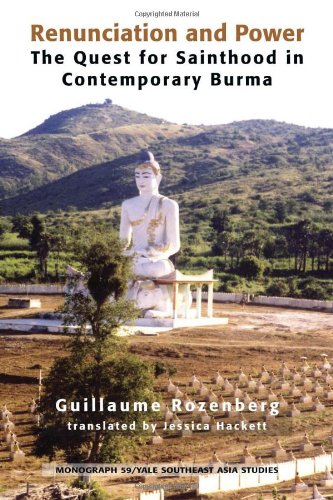Guillaume Rozenberg, Renunciation and Power: The Quest for Sainthood in Contemporary Burma
New Haven: Yale University Southeast Asia Studies, 2010. Pp. xi, 180; figure, map, notes, bibliography.
Reviewed by Matthew J. Walton.
For those interested in religion in Burma/Myanmar, Buddhism appears to be unavoidable. It is the religion of the vast majority of the population and has exerted considerable influence on, for example, social customs and governance. Yet the focus on Myanmar as a “Buddhist nation” (a Burmese claim that is too often unquestioningly adopted by foreign scholars) obscures much of the diversity and complexity of actual religious practice in the country. This applies not only to the Christian, Muslim, Hindu, and animist populations, but also to a wide range of practices that are usually simply labeled as “Buddhism,” or–much more problematically–as “true” or “real” Buddhism, or as something other than that. Scholarly work of the 1950s and 1960s, while revealing some of this complexity in raw data, often contributed to the misunderstanding, either through the imperative of categorization or the desire to separate “real” Buddhism from the chaff of tradition. For example, even as he acknowledged that his categories were for analytical purposes and did not adequately reflect the reality of religious practice, Melford Spiro’s “Nibbanic,” “Kammatic,” and “Apotropaic” Buddhisms have become relatively solid distinctions, even beyond the field of Burmese Buddhism.
Probably because of the significant limitations on scholarly access after the military coup of 1962, Burma’s Buddhism never received the more nuanced analysis that anthropologists such as Charles Keyes and Stanley Tambiah applied to Thai Buddhism. However, a small but now growing number of scholars from more recent generations have been challenging and revising the received wisdom on religious practice in Myanmar, both expanding it beyond the boundaries of Buddhism and recognizing that those boundaries were was never particularly meaningful in the first place. Bénédicte Brac de la Perrière deserves pride of place as the scholar most responsible for insistently opening our eyes to the diversity of religious practice in the country, but Guillaume Rozenberg (who acknowledges his debt to Brac de la Perrière at the beginning of this book) makes an excellent and important contribution with this study of aspiring saints in Burma and their multidimensional relations to lay society, monastic society, and political authorities.
Rozenberg organizes the book in three parts. First is “Values that Qualify,” in which he describes how certain individuals have entered the path to sainthood. Although he examines the forest practitioner and the weikza in separate sections, he demonstrates the overlap by examining some of the same figures in both sections. In the second part, “Activities that Certify,” he considers different ways in which aspiring saints can demonstrate their legitimacy to their followers. These activities include making predictions (Rozenberg also wrote an excellent chapter on a Burmese “lottery monk” in Burma at the Turn of the Twenty-First Century, edited by Monique Skidmore), redistributing (a saintly monk can amplify the merit that laypeople gain from a donation while also creating a minor ecosystem in which donations to him help to support other monks and nuns), and building (either the construction or–more rarely–restoration of Buddhist religious structures). Part three, “Saint By or Against the State?”, examines the difficulties that political entities face when engaging with or trying to co-opt the moral legitimacy of the aspiring saint. The state, in Theravada Buddhist ideology, is responsible for maintaining orthodoxy and supporting the sangha, but renunciate monks must also, as Rozenberg says, “keep a fair distance” (pages135 ff.) from the worldly machinations of the political realm.
This organizational schema serves Rozenberg’s book well, especially as it allows him to weave short descriptions of the lives and activities of a number of aspiring Burmese saints into his narrative. These stories are one of the most useful elements of the book, especially for readers who do not read Burmese, since little of this material has been translated into English. Most of the chapters alternate between short accounts of the lives and activities of saintly figures and more theoretical sections in which Rozenberg situates those figures in the context of Buddhist salvation efforts. These include the monk Thamanya Hsayadaw, who built a vegetarian utopia in the midst of conflict in Karen State; Winsein Hsayadaw, who supervised the construction of a 180-meter-long reclining Buddha; and Myaing Gyi Nu Hsayadaw, better known as U Thuzana, who has undertaken a project of restoring religious monuments in Karen State.
Rozenberg devotes an entire chapter to explaining the concept of the weikza. This term–which Rozenberg translates as “superman” but many other scholars have translated as “wizard”–applies to an individual who, through renunciation and the development of moral perfection, acquires supernatural powers. Usually the purpose of developing these powers is to extend the practitioner’s life until the arrival of the next Buddha, which would presumably make it easier for him to achieve enlightenment. Burmese weikza have intrigued scholars for years and their cults have persisted to the present day, some even spawning underground fan ‘zines. Among the aspiring saints whom Rozenberg profiles, some even claim to be weikza themselves, most notably the monk Thamanya Hsayadaw, a man whose example contradicts the claims of some scholars that only laymen can be weikza. Valuably, Rozenberg’s situates weikza practice within the moral universe of Buddhism. Far from being a path that diverges from the Buddha’s teachings, for the weikza, “Buddhist virtues are an indispensable condition for…success” (page 48). The practice of renunciation thus forms the basis for an aspiring saint’s supernatural powers and for his appeal to the laity.
The chapter on weikza is particularly commendable because of the detail in which Rozenberg examines the term and its various definitions and implications. He is critical of the work of other scholars, noting that, in their efforts to unravel the apparent contradictions in weikza practices and descriptions, they have failed to capture the reality that “the weikza is neither this nor that, it is at the same time this and that” (page 45). Rozenberg recognizes the importance of the inter-relationship of the Burmese terms lawki (mundane) and lawkoktara (supramundane), a tension that creatively informs much of Theravada Buddhist practice. Often, the former is used to refer to mere worldly practices (as weikza powers are often classified), while the latter refers to the Buddha’s path to enlightenment and ultimate liberation from suffering. But Rozenberg reveals the ways in which weikza practitioners actually oscillate between the two states, balancing the two orientations of sainthood, being situated in the world while aiming toward enlightenment.
Rather than examine the doctrinal or theological expressions of sainthood, Rozenberg is interested in the practices of sainthood, what he describes as a “system of culturally determined representations and social relations” (page 151). The second part of the book significantly enriches our understanding of what prominent Buddhist figures “do,” outside the traditional monastic duties of teaching, preaching, and–for some–meditating. Examining the activities of predicting, redistributing, and building, Rozenberg usefully expands the notion of thathana pyu (making religion). He also captures some of the often overlooked areas of daily interaction between laypeople and monks. At a time when the call to protect the thathana (religious community) has spawned anti-Muslim violence in Myanmar, the subject of what the thathana is and how best to preserve and expand it is ripe for a more nuanced understanding; Rozenberg gives us a great deal of material to work with here.
Chapter Six begins by documenting state efforts to reform and centralize the sangha hierarchy throughout the 1980s and 1990s. Rozenberg notes that, once government efforts shifted after 1988 from merely “purifying” Buddhism to “promoting” Buddhism, the work of aspiring saints was not only officially recognized but actively supported and honored. But, as Chapter Seven makes clear, while aspiring saints can benefit from the state’s blessing, in order to retain their moral legitimacy as renunciates they must not appear to be dependent on or overly close to political authorities. Rozenberg uses the example of Thamanya Hsayadaw and his contrasting interactions with former generals and with Daw Aung San Suu Kyi to demonstrate that “the great monk leaves his work open for a vast spectrum of interpretations” (page 142), reinforcing the book’s main argument that aspiring saints inhabit multiple positions and actively play with the ambiguity of terms like weikza and challenge dichotomies such as that between lawki and lawkoktara.
Given the depth of Rozenberg’s field work, it is somewhat surprising how lightly footnoted the text is and how little of what he discusses comes directly from cited interviews or observations. Presumably, like much ethnography, his experiences in the field informed the broader framework in which he analyzes the practices of sainthood. But for such a rich and complex topic this reader occasionally wished for the presence of more Burmese voices. Because of his focus on those aspiring saints who push the boundaries of the traditional monastic model, Rozenberg sometimes risks overstating the conflict between, for example, monks within the traditional hierarchy and the “forest monks” of his study. Some “heads of monastic study centers or urban meditation centers” no doubt criticize the forest tradition, but to label this an “ideological war” is too much; I would venture to guess that this emphasis comes more from the perspective of forest monks and their disciples, eager to insist on the legitimacy (or superiority) of their own practices (pages 40-41).
For the author of an academic text, Rozenberg spends very little time situating his work within the literature on Buddhism in Myanmar or beyond. Most of the main texts on the subject are in the bibliography, but they are very rarely directly mentioned or examined in the text. It is possible that this choice is due to Rozenberg’s believing that much of what came before on the topic of weikzas and non-monastic Buddhist practice is incorrect or one-sided, but on such an understudied topic it would be useful for the reader to understand in greater detail how Rozenberg’s work is a much needed corrective to the more static renderings of previous scholars. Hopefully, the renewed emphasis on the topic among scholars such as Tom Patton–completing a doctoral dissertation at Cornell University on lived religion in Myanmar, which includes weikza cults–will result in more work that reflects Rozenberg’s nuanced approach. Also, while it is gratifying to see Rozenberg use “readable” transliterations of Burmese words, an index would have been a useful addition to the book, especially since the brief vignettes of aspiring saints are scattered throughout.
Renunciation and Power is the first in Rozenberg’s planned trilogy on the weikza path. The second volume (which has been translated from French into English and is currently under review) will study a specific weikza cult in contemporary Myanmar, while the third will focus on exorcism, a practice of some aspiring saints. This is an ambitious project but one that will undoubtedly contribute greatly to our understanding of religious practice in Myanmar and hopefully spur future scholars (especially Burmese scholars) to study the range of phenomena that constitute Buddhist practice in the country. Rozenberg has written an excellent book that scholars of religion and society in Myanmar must read. His attention to the complexity and blurred boundaries of religious categories should be the standard for future scholarship on the subject.
Matthew J. Walton is тАОthe Aung San Suu Kyi Senior Research Fellow in Modern Burmese Studies at St Antony’s College in the University of Oxford.
References
Brac de La Perrière, Bénédicte. Les rituels de possession en Birmanie: du culte d’Etat aux cérémonies privées. Paris: Editions Recherche sur les civilisations, 1989.
Skidmore, Monique, editor. Burma at the Turn of the Twenty-First Century. Honolulu: University of Hawai╩╗i Press, 2005.
Spiro, Melford E. Burmese Supernaturalism: A Study in the Explanation and Reduction of Suffering. Englewood Cliffs, New Jersey: Prentice-Hall, 1967.
______. Buddhism and Society: A Great Tradition and its Burmese Vicissitudes. New York: Harper and Row, 1970.
 Facebook
Facebook  Twitter
Twitter  Soundcloud
Soundcloud  Youtube
Youtube  Rss
Rss 
